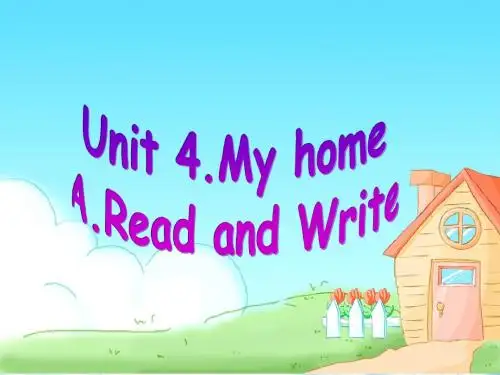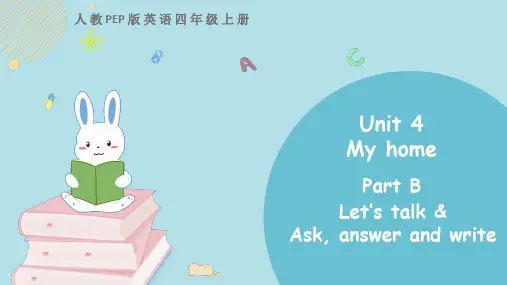PEP四年级英语上册 Unit 4 第五课时-优质课件
- 格式:ppt
- 大小:5.36 MB
- 文档页数:37

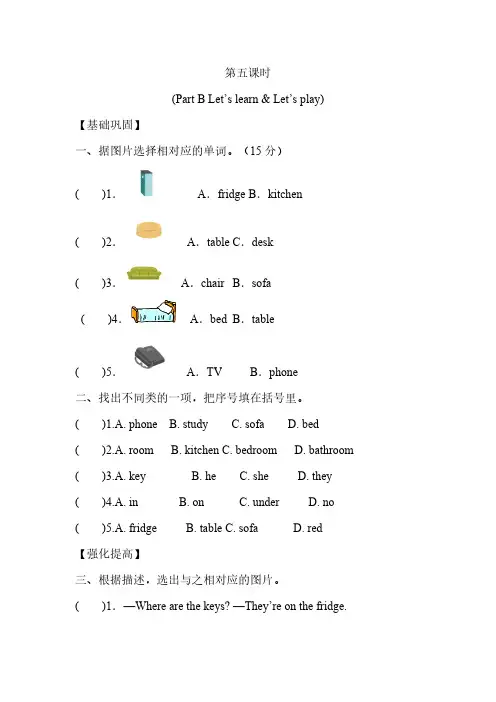
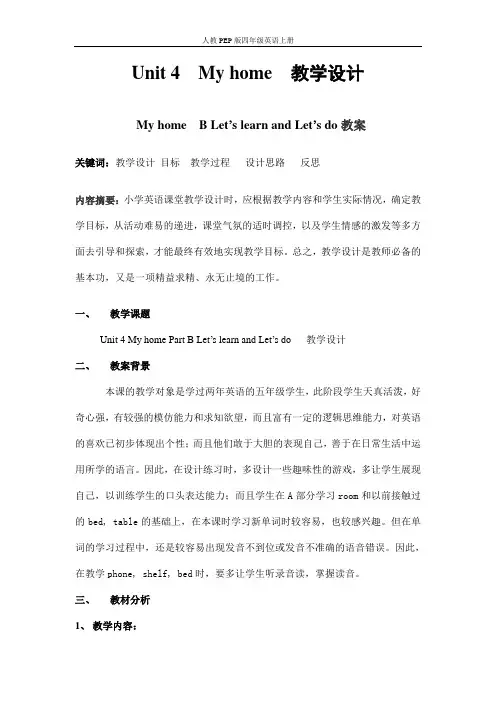
Unit 4 My home教学设计My home B Let’s learn and Let’s do教案关键词:教学设计目标教学过程设计思路反思内容摘要:小学英语课堂教学设计时,应根据教学内容和学生实际情况,确定教学目标,从活动难易的递进,课堂气氛的适时调控,以及学生情感的激发等多方面去引导和探索,才能最终有效地实现教学目标。
总之,教学设计是教师必备的基本功,又是一项精益求精、永无止境的工作。
一、教学课题Unit 4 My home Part B Let’s learn and Let’s do 教学设计二、教案背景本课的教学对象是学过两年英语的五年级学生,此阶段学生天真活泼,好奇心强,有较强的模仿能力和求知欲望,而且富有一定的逻辑思维能力,对英语的喜欢已初步体现出个性;而且他们敢于大胆的表现自己,善于在日常生活中运用所学的语言。
因此,在设计练习时,多设计一些趣味性的游戏,多让学生展现自己,以训练学生的口头表达能力;而且学生在A部分学习room和以前接触过的bed, table的基础上,在本课时学习新单词时较容易,也较感兴趣。
但在单词的学习过程中,还是较容易出现发音不到位或发音不准确的语音错误。
因此,在教学phone, shelf, bed时,要多让学生听录音读,掌握读音。
三、教材分析1、教学内容:义务教育课程标准实验教科书PEP英语小学英语四年级上册Unit 4 My home Part B Let’s learn and Let’s do2、内容分析:这个课时主要是在学习A 部分有关room的内容后围绕家具、电器展开的单词和指令的学习,Let‘s learn 部分主要学习家具、电器的单词,Let’s do 部分是围绕单词而展开的指令活动,主要训练学生听指令做事情的能力,在活动中掌握词汇。
学生在已有的知识基础上也接触过一些家具、电器单词的学习,例如,chair, bed, door, computer, TV, light, fan等有关的单词,本课时的单词是学生日常生活中经常接触到的一些物品,而且也比较简单;所学习的指令的节奏感也很强,因此,学生学起来比较有兴趣。
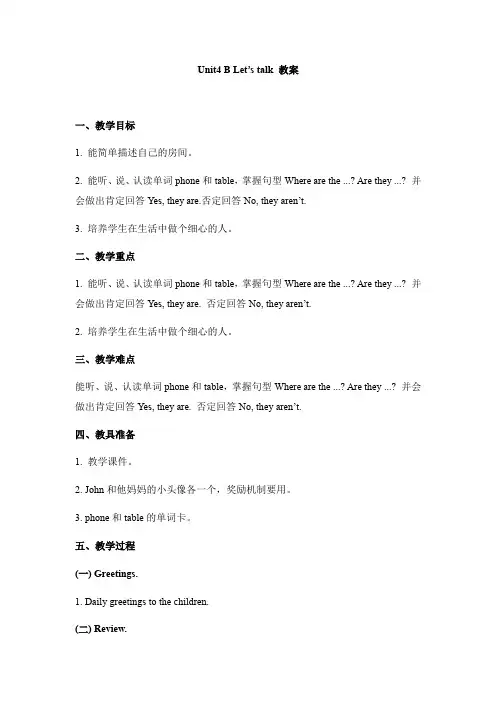
Unit4 B Let’s talk 教案一、教学目标1. 能简单描述自己的房间。
2. 能听、说、认读单词phone和table,掌握句型Where are the ...? Are they ...? 并会做出肯定回答Yes, they are.否定回答No, they aren’t.3. 培养学生在生活中做个细心的人。
二、教学重点1. 能听、说、认读单词phone和table,掌握句型Where are the ...? Are they ...? 并会做出肯定回答Yes, they are. 否定回答No, they aren’t.2. 培养学生在生活中做个细心的人。
三、教学难点能听、说、认读单词phone和table,掌握句型Where are the ...? Are they ...? 并会做出肯定回答Yes, they are. 否定回答No, they aren’t.四、教具准备1. 教学课件。
2. John和他妈妈的小头像各一个,奖励机制要用。
3. phone和table的单词卡。
五、教学过程(一) Greetings.1. Daily greetings to the children.(二) Review.1. Warm-up.“Let’s sing”复习与本课有关的旧知,复习已学单词。
2. Lead in.T: This is John’s home. It’s so beautiful. What’s in his home?Ss: There is/are ...复习已学单词,教授新单词phone和table。
(三) Presentation.1. 以猫偷鱼的故事贯穿整堂课,T: Listen, who is coming? Ss: It’s a cat. T: Where is the cat? Is it on the sofa? 让学生做出回答,复习以be动词开头的单数名词一般疑问句以及它的肯定和否定回答方式。
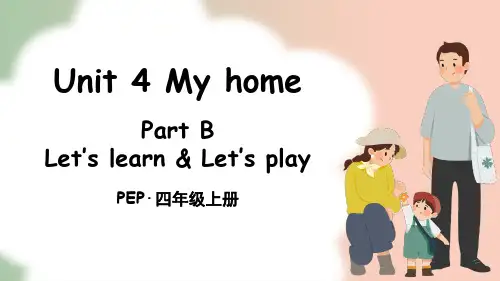
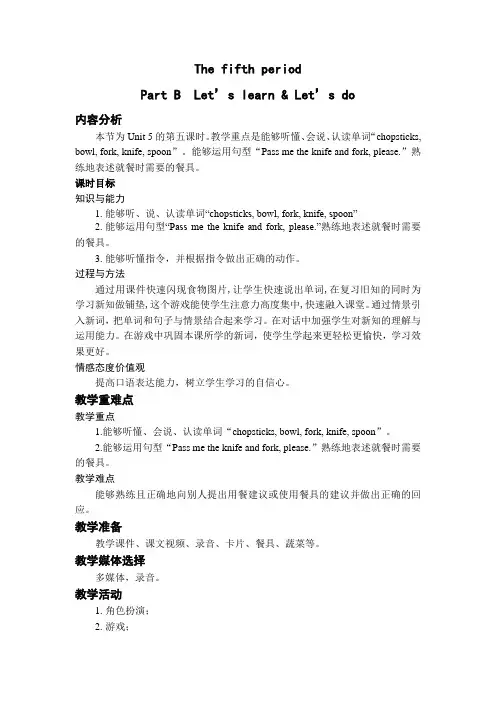
The fifth periodPart B Let’s learn & Let’s do内容分析本节为Unit 5的第五课时。
教学重点是能够听懂、会说、认读单词“chopsticks, bowl, fork, knife, spoon”。
能够运用句型“Pass me the knife and fork, please.”熟练地表述就餐时需要的餐具。
课时目标知识与能力1.能够听、说、认读单词“chopsticks, bowl, fork, knife, spoon”2.能够运用句型“Pass me the knife and fork, please.”熟练地表述就餐时需要的餐具。
3.能够听懂指令,并根据指令做出正确的动作。
过程与方法通过用课件快速闪现食物图片,让学生快速说出单词,在复习旧知的同时为学习新知做铺垫,这个游戏能使学生注意力高度集中,快速融入课堂。
通过情景引入新词,把单词和句子与情景结合起来学习。
在对话中加强学生对新知的理解与运用能力。
在游戏中巩固本课所学的新词,使学生学起来更轻松更愉快,学习效果更好。
情感态度价值观提高口语表达能力,树立学生学习的自信心。
教学重难点教学重点1.能够听懂、会说、认读单词“chopsticks, bowl, fork, knife, spoon”。
2.能够运用句型“Pass me the knife and fork, please.”熟练地表述就餐时需要的餐具。
教学难点能够熟练且正确地向别人提出用餐建议或使用餐具的建议并做出正确的回应。
教学准备教学课件、课文视频、录音、卡片、餐具、蔬菜等。
教学媒体选择多媒体,录音。
教学活动1.角色扮演;2.游戏;3.观看动画。
教学过程Step 1: Warm-up & Lead-in1. Greetings.2. Let’s chant.3. Sharp eyes.T:Now let’s play a game. When you see the picture, try to say the word as quickly as you can. (课件出示:egg, juice, bread, milk, water, fish, rice, cake,beef, chicken, noodles, soup, vegetables的图片逐一快速闪现)4. Lead-in.T: Do you know what I would like? Can you guess?S1: Would you like some bread?T: No, thanks.S2: Would you like some beef?T: Yes, please.…T:What would I like? Yes, I’d like some beef,… (Write down the food the teacher likes on the blackboard.)Step 2: Presentation1. Teach the new words and sentences.(1)Teach the words “pass, knife, fork”.(教师拿出餐具:chopsticks, a knife and fork, a spoon, a bowl)T: Oh, I’m hungry. I’d like some beef. How can I eat it?I can use…S1: A knife and fork.T: Good. I can use a knife and fork. Pass me the knife and fork. Pass/pɑːs/, a/ɑː/, pass/pɑːs/. Pass me the knife and fork.Write down the sentence “Pass me the knife and fork.” on the blackboard and teach it.T: Thank you. Knife/naɪf/, kn/n/-i/aɪ/-fe/f/. Knife, knife, cut with the knife. (教师边说边做动作,学生跟读)T: Fork/fɔ:k/, or/ɔ:/. Fork, fork, use the fork. (教师边说边做动作,学生跟读)T: Look! The knife is in my right hand. The fork is in my left hand. Then cut with the knife and use the fork to eat. Can you use them now?S1: Yes, I can. Let me show you.T: Great! Can you use the knife and fork?S2:No, I can’t.T: Let me help you.(2)Te ach the word “bowl”.T:(Show a bowl.) What’s this?S2:碗。

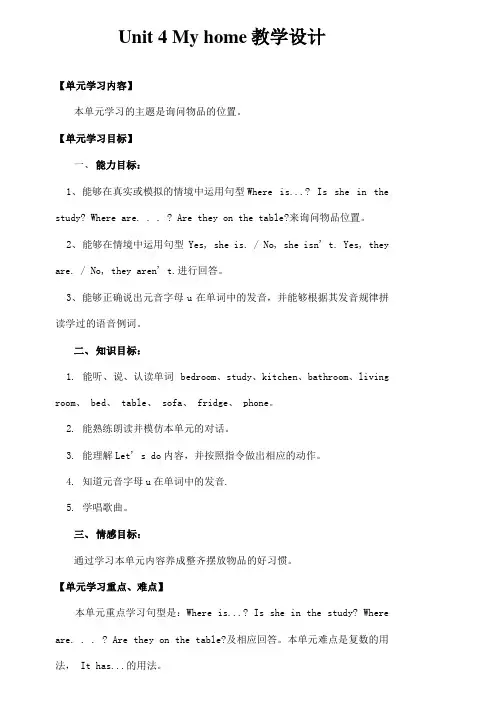
Unit 4 My home教学设计【单元学习内容】本单元学习的主题是询问物品的位置。
【单元学习目标】一、能力目标:1、能够在真实或模拟的情境中运用句型Where is...? Is she in the study? Where are. . . ? Are they on the table?来询问物品位置。
2、能够在情境中运用句型 Yes, she is. / No, she isn' t. Yes, they are. / No, they aren' t.进行回答。
3、能够正确说出元音字母u在单词中的发音,并能够根据其发音规律拼读学过的语音例词。
二、知识目标:1.能听、说、认读单词bedroom、study、kitchen、bathroom、living room、 bed、 table、 sofa、 fridge、 phone。
2.能熟练朗读并模仿本单元的对话。
3.能理解Let' s do内容,并按照指令做出相应的动作。
4.知道元音字母u在单词中的发音.5.学唱歌曲。
三、情感目标:通过学习本单元内容养成整齐摆放物品的好习惯。
【单元学习重点、难点】本单元重点学习句型是:Where is...? Is she in the study? Where are. . . ? Are they on the table?及相应回答。
本单元难点是复数的用法, It has...的用法。
【课时安排】第一课时: ALet' s talk第二课时: ALet' sLearn第三课时: ALet' sspell第四课时: BLet' s talk 第五课时: B Let's learn Let' s check Let' s sing Storytime第一课时【学习目标】一、 能力目标:1. 能用Is it/she …?询问物品所在。
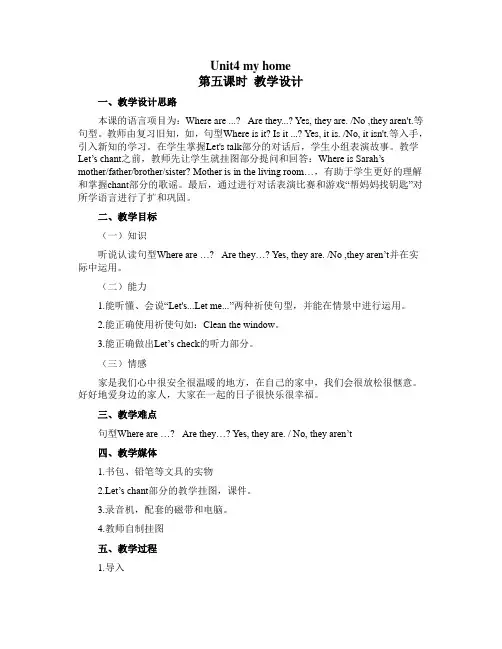
Unit4 my home第五课时教学设计一、教学设计思路本课的语言项目为:Where are ...? Are they...? Y es, they are. /No ,they aren't.等句型。
教师由复习旧知,如,句型Where is it? Is it ...? Yes, it is. /No, it isn't.等入手,引入新知的学习。
在学生掌握Let's talk部分的对话后,学生小组表演故事。
教学Let’s chant之前,教师先让学生就挂图部分提问和回答:Where is Sa rah’smother/father/brother/sister? Mother is in the living room…,有助于学生更好的理解和掌握chant部分的歌谣。
最后,通过进行对话表演比赛和游戏“帮妈妈找钥匙”对所学语言进行了扩和巩固。
二、教学目标(一)知识听说认读句型Where are …?Are they…? Yes, they are. /No ,they aren’t并在实际中运用。
(二)能力1.能听懂、会说“Let's...Let me...”两种祈使句型,并能在情景中进行运用。
2.能正确使用祈使句如:Clean the window。
3.能正确做出Let’s check的听力部分。
(三)情感家是我们心中很安全很温暖的地方,在自己的家中,我们会很放松很惬意。
好好地爱身边的家人,大家在一起的日子很快乐很幸福。
三、教学难点句型Where are …?Are they…? Y es, they are. / No, they aren’t四、教学媒体1.书包、铅笔等文具的实物2.Let’s chant部分的教学挂图,课件。
3.录音机,配套的磁带和电脑。
4.教师自制挂图五、教学过程1.导入(1)教师先带领学生复习Let’s do部分的内容。
开始时,教师发指令,学生做动作。
